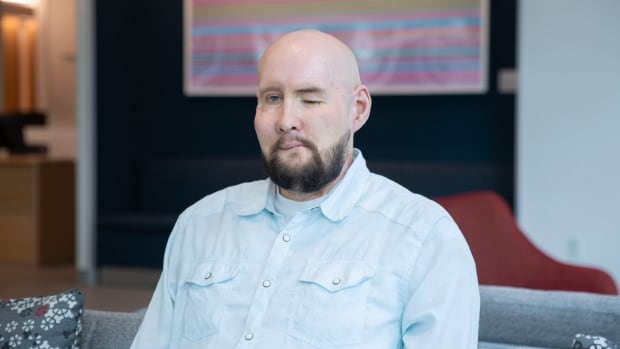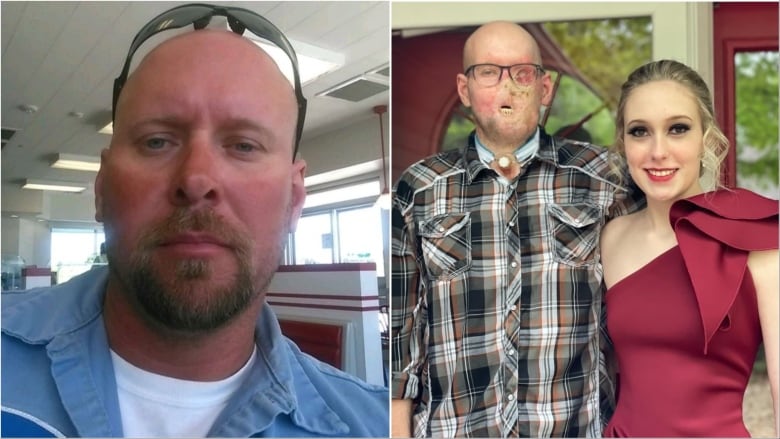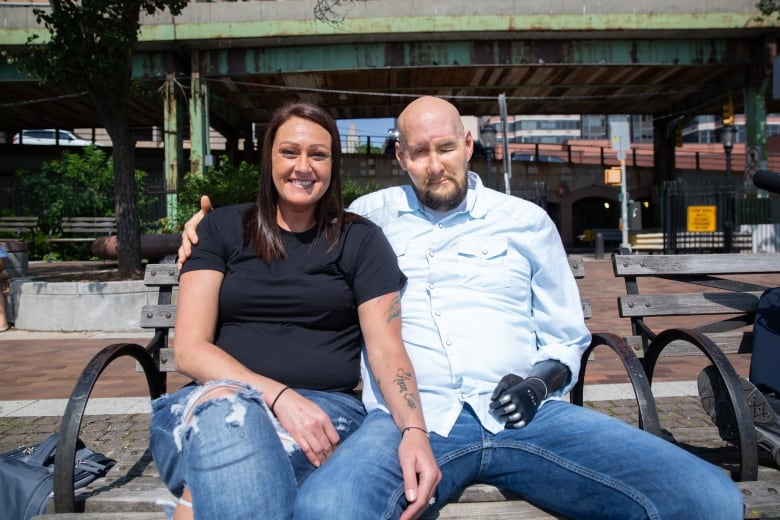
As It Happens7:39Man who received world’s 1st eye and face transplant says it changed his life
Aaron James can’t stop looking at himself in the mirror.
The 47-year-old U.S. military veteran and electrical lineman was badly injured in a workplace accident in June 2021 that destroyed his left eye, chin, nose, lips and left arm, and left much of face badly damaged by electrical burns.
For a long time afterward, the Hot Springs, Ark., man says he didn’t feel like himself. He couldn’t smell or taste anything. And wherever he went, people stared.
But now, one year after he received what his medical team says is the the world’s first whole eye and partial face transplant, he’s finally getting comfortable again with the face that greets him in the mirror.
“I see me,” James told As It Happens host Nil Köksal. “That’s why I look at myself so much, because it’s still mind-blowing to me.”
James can’t see out of his new eye, but his doctors say the fact that it appears healthy and well integrated one year later is a huge win for science, and brings them one step closer to one day being able to restore vision through transplant surgery.
Face transplants are rare, and James’s whole eye transplant was a world-first, according to his medical team at NYU Langone Health in New York City, who have described his progress in the medical journal JAMA.
‘We don’t know if it’s going to work’
James says he was already signed up for facial surgery when his medical team approached him about integrating an experimental eye transplant. Both the face and eye were from the same donor.
He underwent the 21-hour-long procedure in May 2023, a feat made possible through the collaboration of more than 140 medical professionals.
He knew it was risky, he says, and that it might not work. His body could have rejected the new eye. And there was — and still is — no guarantee he will ever regain his lost vision.
But he also knew that whatever happened, the data his medical team collected would prove invaluable for others in similar situations, he said.

There are more than 40 million people worldwide who can’t see out of both eyes, according to an editorial comment in JAMA, sometimes due to disease, and sometimes because of injury. And there is currently no way to restore that lost vision.
James’s surgery is a step on the path to changing that.
“They told me from the beginning, you know: This has never been done. We don’t know if it’s going to work,” he said. “But I trusted them.”
Plus, James figured, he had nothing to lose — and everything to gain.
“I’m already going to be on immunosuppressants for the rest of my life [and] I didn’t have an eye there to begin with.”
Why is it so hard to replace an eye?
Doctors have long been studying the possibility of treating vision through eye transplants, but the organ is a particularly tricky one to integrate because of the complex way it interacts with the brain.
In animal testing so far, transplanted eyes have been rejected by their recipients, shrinking and deteriorating over time, the study’s authors said.
But, so far, in James’s case, that hasn’t been the case.
“Aaron cannot perceive light when we shine light into his eye, but when we look at the eye itself, it really looks incredible,” said Dr. Vaidehi Dedania, an ophthalmologist at the NYU Grossman School of Medicine, who has been monitoring James’s recovery and co-authored the study.
“It is nice and round, so it is not shrivelled or shrunk at all. And what that tells us is that the eye is receiving a good enough blood supply that it can make its own fluid, just like our body can make blood from bone marrow. And so the eye is sustaining itself.”
While the eye has not regained vision, tests show the retina has an electrical response to light, suggesting the rods, codes and light-sensitive nerve cells all survived the surgery intact.
That fact provides hope for vision restoration in future transplants, says Dr. Eduardo D. Rodriguez, the study’s senior author and James’s lead surgeon.
“We are truly amazed by Aaron’s recovery, with no episodes of rejection,” he said in an NYU press release.
He credited the team’s “methodical approach to the matching process, ensuring that Aaron received the most favourable donor match” along with a unique and rigorous immunosuppression regimen.
“Our discoveries over the past year mark promising initial results, laying a foundation for further advancements and ongoing research.”
Dr. Bohdan Pomahač, a surgeon at the Yale School of Medicine who performed the first full facial transplant in the U.S. in 2011, called it “a technically brilliant operation.”
“The authors pushed the boundaries of innovation,” Pomahač, who was not involved in Jame’s case, told Nature.
The key to restoring vision is figuring out how re-grow the optic nerve, which carries light signals from the retina to the brain’s vision centre, the authors say.
“You take one step at a time,” Dedania said. “This at least gives us some runway now to work with to get to that next step.”
Eating is fun again
The surgery has dramatically impacted James’s life. His face transplant has not only changed how he sees himself and is perceived by others, but it also restored his sense of taste and smell.
He says he can’t remember whether he first food he fully savoured after surgery was applesauce or chocolate pudding. “I just remember it was real good,” he said.

His recovery has been welcomed by his wife and daughter, he said, noting that accidents like his have a ripple effect, impacting the lives of the victims loved ones.
“When my accident happened, our daughter, she was 16 years old and, you know, 16-year-olds, they have enough issues as it is, trying to grow up now [and] you throw this on top of it,” he said. “But she handled it good. She’s strong. She graduated high school [and is] going to college now.”
But beyond the personal impacts of the procedure, James says he’s proud to be a part of medical history.
“Everybody wants to do their part in, you know, helping out,” he said. “Maybe this is my part.”